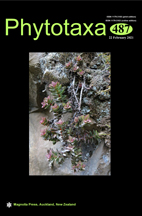Abstract
Within the framework of a taxonomic revision of subfamily Urgineoideae based on morphological, genetic and phytogeographic data covering numerous samples from its whole range of distribution, we here describe a new genus and species from Pella se Berge in northwestern South Africa. Triandra gen. nov. is easily characterized by the absence of stamens associated with the outer tepal whorl, therefore having only three stamens per flower, a character previously unknown in Hyacinthaceae. Triandra pellabergensis sp. nov. produces hypogeal bulbs with filiform proteranthous leaves, spurred bracts, lax racemes with few, nodding, nocturnal flowers and erect capsules with the withered tepals persisting atop. The new species resembles Urginea revoluta in general morphology, although this latter species has six stamens per flower, a different seed morphology, a distinct phytogeographic pattern, and a distant phylogenetic relationship. A complete morphological description is presented for the new genus and species, including data on its biology, ecology and distribution.

